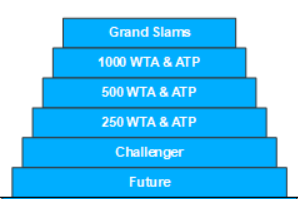Tennis tournaments for tennis beginners
Learn how a tennis tournament works
How do tennis tournaments work?
Many tennis beginners have improved their own stroke technique on the tennis court and are highly motivated to finally apply what they have learned at a tennis tournament. But how does a tennis tournament actually work? What do I have to consider at a tennis tournament?
For all tennis players, a tennis tournament is about fame and glory, and for professional tennis players, it’s about a lot of money. In singles, only one tennis player can call himself a tournament winner at the end of the tournament. All other tournament participants have lost a tennis match. Below we have outlined what tennis beginners need to know about tennis tournaments – enjoy reading.
1. Tennis tournament structure
All tennis players have the same goal in the tennis tournament: to win the tournament. The number of participants and the tournament mode may vary. Below we describe the chronological tournament process:
a) Entry deadline
For all tennis tournaments there is an entry deadline. This is the date until which tennis players can register for the tournament.
b) Tournament draw
After the registration deadline the tournament draw will take place. Here a distinction is made between professional tennis tournaments with a fixed number of participants and amateur tennis tournaments.
While in professional tennis tournaments the entries often exceed the capacities and entries are rejected, in amateur tennis tournaments the field size is often adjusted to the number of entries, so that all tennis players may participate in the tournament.
While professional tournaments use a knockout tournament mode to determine the tournament winner, amateur tennis tournaments first determine the tournament mode:
Box games
The so called box matches are often used when there are only very few participants in an age competition, e.g. when there are 5 entries. In this case everyone plays against everyone and at the end it is added up who has won the most victories, sets and games. It is the only form of tournament in which a tennis match can potentially be lost, but you can still emerge as the tournament winner in the end.
KO main round with side round
The KO Main Round with Secondary Round ensures each participant at least two tennis matches. Any tournament participant who loses in their own first round will be added to the list for the side round. After each tennis player has played their own first round and the participants of the side round have been determined, a separate knockout tournament will be drawn. This ensures that players who might have been unlucky in the main knockout round get another chance. With the 2nd defeat the tournament is over.
KO main round with qualification
The KO main round with qualification is used on the professional tour. If there are too many entries for a fixed number of participants, a qualification over 1-3 rounds will be played.
The winners of the qualification rounds qualify for the KO main round. Therefore, the qualification will be played before the KO main round starts. If a player withdraws from the KO main round shortly before the start of the tournament, e.g. due to an injury, a so-called lucky loser, a player who lost the last qualifying round, can still advance to the KO main round.
In addition, there are often so-called wildcards, which are awarded to players who would not have qualified for the tournament under normal circumstances. These are often awarded to up-and-coming talent, locals or crowd favorites.
In every tournament draw, regardless of the tournament mode, the registered tennis players are sorted either according to the world ranking list, the national ranking list or the club’s own ranking list.
The best tennis player according to these criteria will be seeded on position 1, the second best tennis player on position 2, and so on.
The following field sizes result in the following seeding list:
- 8-player field size: 2 seeded tennis players
- 16-player field size: 4 seeded tennis players
- 32-player field size: 8 seeded tennis players
- 64-player field size: 16 seeded tennis players
- 128-er field size: 32 seeded tennis players
Seeding the best tournament participants ensures that #1 does not play #2 in the 1st round. Thus, the matchup of number 1 against number 2 is only possible in the final.
For example, if 14 players register for a tournament, the number 1 and 2 seeded players will receive a bye in the first round, also called a rest.
The unseeded players will be drawn at random or by lottery.
c) Scheduling of the tournament matches
After the draw, the tournament organizer has the task of scheduling the drawn matches. This includes the date and time, but also the corresponding court number.
Since tennis matches can vary in length depending on the course, tournament participants should be flexible with regard to both the scheduled start time and the scheduled court number.
Normally, even at the amateur level, a maximum of two official tournament matches are scheduled per day so that participants can regenerate from intense and exhausting tennis matches.
In addition, we have created a digital reference book for all tennis terms with our tennis glossary.
2. Famous tennis tournaments: Grand Slams vs. Futures

An incredible number of tennis tournaments are held every year. From Grand Slams, ATP and WTA tournaments, Challengers, Futures, German ranking tournaments, LK tournaments to club championships.
a) Grand Slam tournaments
The four Grand Slam tournaments Australian Open, French Open, Wimbledon and US Open are the most famous tennis tournaments in the world. Here, not only the biggest records are played for, but also the most money. It is played in men’s and women’s singles, men’s and women’s doubles and mixed. All competitions will be played in parallel.
With 128 participants in the king disciplines, the women’s and men’s singles, and prior qualification over 3 rounds, tennis players must win up to 10 matches to finish the tournament victorious.
The most Grand Slam titles in women’s singles count Margaret Court, Serena Williams, Steffi Graf, Helen Wills Moody, Chris Evert and Martina Navratilova.
The most Grand Slam titles in men’s singles count Rafael Nadal, Roger Federer, Novak Dokovic, Pete Sampras and Roy Emerson.
b) 1000 ATP & WTA tournaments
In both the women’s and men’s tournaments, so-called 1000s tournaments are held in which the tournament winners receive 1000 world ranking points. The tournaments are played in women’s and men’s singles, women’s doubles and men’s doubles. However, the women’s and men’s competitions are usually played at different times and at different venues.
Field sizes range in singles from 128 to 64 with rests for the top seeded players in the first round. In addition, there is a qualifying opportunity.
c) 500 and 250 ATP & WTA Tournaments
In both the women’s and men’s tournaments, so-called 500 and 250 tournaments are held in which the tournament winners receive 500 and 250 world ranking points, respectively. The tournaments are played in women’s and men’s singles, women’s doubles and men’s doubles. However, the women’s and men’s competitions are usually held at different times and at different venues.
Usually, several tournaments are held in parallel at different venues and court surfaces, allowing players to choose according to personal preferences.
Field sizes range from 64 to 32 in singles with partial rests for the top seeded players in the first round. In addition, there is a qualifying option.
d) Challenger tournaments
While very good prize money can be earned in the ATP & WTA tournament categories, the Challenger tournament category is an intermediate level through which players must work their way up. It is played in men’s and women’s singles, men’s and women’s doubles.
e) Future Tournaments
In the Future Tournament category, players compete for the first time for world ranking points. Several Futures are held every week from January to November all over the world. In this category the prize money usually does not even cover the expenses, so the players pay on top.
As soon as a world ranking point has been won, one is listed in the world ranking list.
3. Tennis tournament winner
Especially for tennis beginners it is important to mention again that there is only one tournament winner at the end of every tennis tournament. Even the finalist goes home with a defeat in his luggage.
Accordingly, losing a tennis match is simply part of tennis. There is no tennis player who has played a season without defeat.
The sport of tennis teaches bad losers to at least deal with defeats in order to fully attack again at the next tennis tournament. Therefore, a tennis match is also often decided in the head, where the mentally stronger tennis player ends up winning the tennis match.
Especially tennis beginners, who are not used to competitive tennis, often cannot reach their training level in an official tennis match due to, among other things, nervousness. Therefore, we recommend every tennis beginner to participate in any offered possibilities to play a tennis match under competition conditions. Freely after the motto practice makes perfect.
4. Summary and conclusion
At the end of a tennis tournament, there is only one tournament winner. All other tournament participants are eliminated by a defeat and must defeat as quickly as possible, in order to be able to start the next to start the next tennis tournament in the best possible way.
In case there are professional tournaments in your area, a visit to one of the facility is definitely worthwhile for for anyone interested in tennis.

